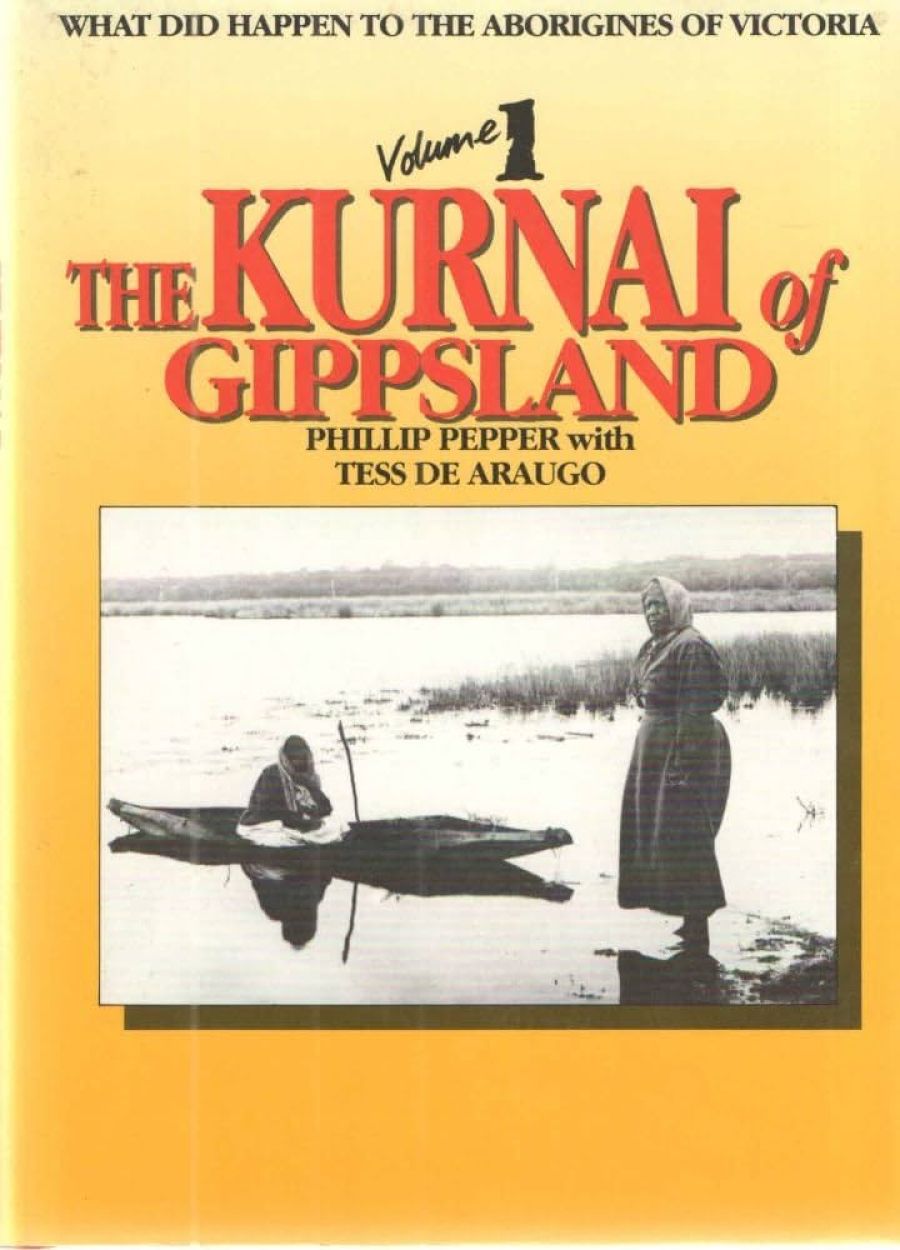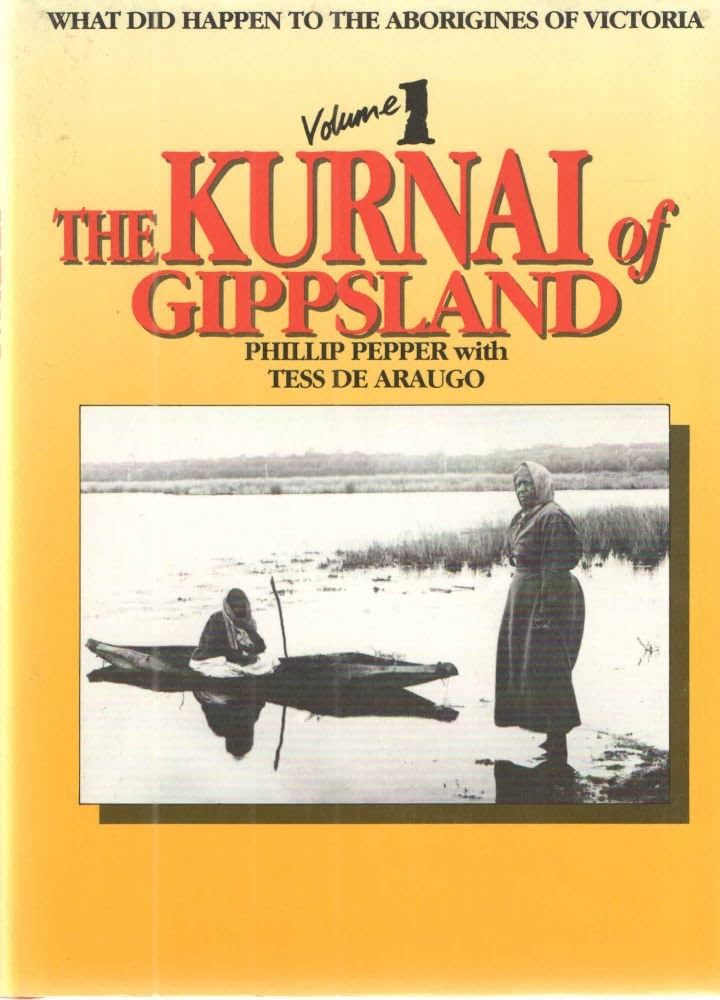
- Free Article: No
- Contents Category: Indigenous Studies
- Review Article: Yes
- Article Title: From Bureaucratese to Reality
- Article Subtitle: The last of the tribe
- Online Only: No
- Custom Highlight Text:
In 1981 the historian Peter Gardner wrote a moving article in the Victorian Historical Journal on the fate of the Gippsland aboriginal leader Bunjilene, who was thought to be holding a lost white woman supposedly captured by aboriginals in the early 1840s. Bunjilene was first taken into custody by Commissioner Tyers at Eagle Point near Bairnsdale in 1847, but while escaping, his son drowned in the lakes. This was the first in a series of tragedies which was to eliminate the Bunjilene family. When he couldn’t produce the white woman, he was taken as punishment to the Native Police station near Dandenong, even though the authorities knew he could not legally be kept prisoner. Here he was chained to a gumtree for long periods. His wife soon died, and after 18 months of illegal detention Bunjilene himself passed away from ‘grief’. Their two sons were taken away to be educated like whites and displayed around Melbourne. One died early, and the other, after some tragic incidents which revealed his disorientation, succumbed to fever and consumption in 1865. He was only eighteen-years-old.
- Book 1 Title: The Kurnai of Gippsland
- Book 1 Subtitle: Volume 1
- Book 1 Biblio: Hyland House, $30.00 pb, 322 pp
- Book 1 Cover (800 x 1200):

Peter Gardner called his article on Bunjilene ‘A Melancholy Tale’. His fate exactly symbolized that of his people, the aboriginal race of Gippsland, and the present book could be called ‘The Melancholy Tale of the Kurnai People.’ For the first time we have a coherent narrative history of the decimation of the Kurnai race. The process was relentless; nothing could stop it, and nothing can stop the reader facing it in this wonderfully told, but unbelievably tragic, story. It is written from the aboriginal side by Phillip Pepper, with the help of Tess De Araugo. Phillip Pepper’s grandfather, Nathaniel Pepper, was the first aboriginal baptized at a Gippsland mission station, and he comes from a family which has kept the legends and anecdotes of his people alive. Sadly, although he spoke at the launching of this book in August, Phillip Pepper died in October, well into his eighties.
The authors adopt an appropriately restrained attitude in telling their story: the facts are so horrific that they simply have to be recounted to have their full impact; there’s no need to point a moral or adorn a tale, except occasionally in translating bureaucratese into reality. About the Half-Caste Act (1886) the Secretary of the Board for the Protection of Aborigines wrote:
...the intention was to merge the half-castes into the white population, but so long as the Reserves are retained for the Aborigines, there is nothing in the Act to prevent the halfcastes from going on to them. An order in Council might prevent it by prescribing the residence of each – but that would be difficult. However I don’t think we need trouble about it. When there is no food on the stations to be obtained, they will certainly not remain.
The authors add a simply explanatory comment to this: ‘In other words, the legal position was shaky, but starvation would serve!’
The first third of the book is devoted to early skirmishes and massacres, plus the fullest account of the captive white woman episode (seven chapters) in print, including three cases of actual white women lost, and a detailed account of a Snowy River massacre. The hunt for the white woman became an excuse for harrying, displacing and in some cases killing the Kurnai. Phillip Pepper has added Kurnai oral tradition, which in some details (e.g. the red hair of the lost woman) fits in with historical versions.
It was Peter Gardner who opened up the questions of the massacres, the white woman and the Bunjilene story over the last fifteen years in a series of articles now collected as Gippsland Massacres: The Destruction- of the Kurnai Tribe 1806-1860. The Kurnai of Gippsland’s early chapters are on the same themes, and, though it doesn’t help the aboriginals in the larger scheme of things, I think the authors should have, for academic reasons, acknowledged that their account is a filling out of Gardner’s pioneering work.
The Kurnai are relatively well documented for two reasons. The explorer and anthropologist, Dr Howitt, became interested in them last century, publishing two major books. He got into trouble with the Mission Stations for trying to resurrect corroborees and other tribal customs, as the present book shows. In addition, as the population dwindled, aborigines on Mission Stations around Victoria were sent to Lake Tyers in the first decade of this century, where they have a continuity through family history and memory to this day, though there is very little pre-European material. Of course, they were not entirely eliminated and we are at present witnessing a recovery of some of their traditions, of which this book is both a product and a source for further development.
The Kurnai were reduced from about three thousand to three hundred in the two decades from 1840-60 After that, most went on to two mission stations. Ramahyuck on Lake Wellington superintended by the Moravian missionary Rev. Hagenauer, and Lake Tyers (called Bung-yarnda by the aboriginals) with Rev. John Bulmer. Their subsequent history becomes that of the families on these missions, and of their relations with the more undefined groups who lived off the reserves. The Kurnai were a graceful, charming and highly intelligent people, who picked up European learning very quickly, as the many letters reproduced in original form in this book reveal. But on the other hand they were continually sick; at times there were almost no men who were healthy enough to work on the stations. They died off.
The Protection Board controlled aboriginals by the use of rations, movement passes, breaking up families and so on. The worst legislation was the Half-Caste Act (1886), whose effect was to split up half- and full-blooded aborigines. The full bloods were to die out on the stations, while the half-castes were to mix and marry in white society where their ‘bad’ black genes would gradually be swamped.
How deliberate and conscious this policy was we cannot tell, because, apart from the initial massacres, there emerge in this book no identifiable villain or villains, either personal or institutional. Everything conspired towards the Kurnai’s elimination, even the humanitarian element in the community, which tried to help them during the white woman hunt and on the reserves. The whole community moved inexorably in the direction of destruction; good intentions caused their downfall as much as bad ones. This actually makes the Kurnai story much more appalling, since there was no possibility of remedy or alleviation.
The book is well produced and profusely illustrated. The authors seem to have read Dr Ewing’s Sale diary, previously denied to researchers. Anthony Trollope’s controversial account of Ramahyuck is not mentioned. The murders of Roland Macallister on page eighteen and Donald Macallister on page twenty-four are probably variant versions of the same incident, not two separate events as described here.
I happened to be reading Graham Jenkin’s Conquest of the Ngarrindjeri on the aborigines of the Lower Murray and the Coorong in S.A. while reading The Kurnai of Gippsland, and the similarities are striking. Anyone wanting an account in microcosm of what happened to the aborigines in Australia couldn’t do better than to read Pepper and De Araugo’s book.


Comments powered by CComment